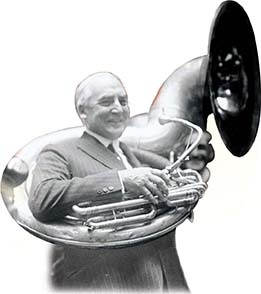SECTION 2: The Business of Government

▲ President Harding joins a parade.

Harding campaign button ►
WITNESS HISTORY  AUDIO
AUDIO
A Fun-Loving President
In 1920, voters turned from the intellectualism and rigid idealism of Woodrow Wilson to someone who presented himself as an average American, Warren G. Harding. “I am a man of limited talents from a small town,” Harding admitted. “I don’t seem to grasp that I am President.” The genial politician from Marion, Ohio, got more pleasure from golf, poker, and music. He once claimed that he could play every band instrument “but the slide trombone and the e-flat cornet.” But what Harding loved most was shaking hands with tourists who visited the White House:
“I love to meet people. It is the most pleasant thing I do; it is really the only fun I have. It does not tax me, and it seems to be a very great pleasure to them.”
—Warren G. Harding, U.S. President
Objectives
- Analyze how the policies of Presidents Harding and Coolidge favored business growth.
- Discuss the most significant scandals during Harding’s presidency.
- Explain the role that the United States played in the world during the 1920s.
Terms and People
- Andrew Mellon
- Herbert Hoover
- Teapot Dome scandal
- Calvin Coolidge
- Washington Naval Disarmament Conference
- Kellogg-Briand Pact
- Dawes Plan
NoteTaking
Reading Skill: Compare and Contrast Note similarities and differences between Presidents Harding and Coolidge.

Why It Matters In 1920, Warren G. Harding was elected President on a pledge of a “return to normalcy.” Rather than pursue reform, as the Progressives had done, Harding and his successor, Calvin Coolidge, favored more conservative policies that aided the growth of business. This pattern—a period of activism followed by a more laissez-faire approach—would repeat itself in the 1950s and 1980s. Section Focus Question: How did domestic and foreign policy change direction under Harding and Coolidge?
The Harding Administration
What exactly did a “return to normalcy” mean? Different voters saw different things in the vague phrase. Some saw it as a retreat from involvement in world affairs, others as a rejection of Progressive reform efforts or a swing back to laissez-faire economics. Once in office, however, Harding had to give substance to his promise.
New Policies Favor Big Business
Harding signaled the economic direction of his administration by naming wealthy banker Andrew Mellon Secretary of the Treasury. Mellon’s idea of prudent economic policy was to support legislation that advanced business interests. He disliked the relatively new income tax, favoring instead low taxes on individuals and corporations. Mellon also cut the fat from the budget. By 1925, Congress had reduced spending from a wartime high of $18 billion to $3 billion. Instead of sinking deeper into debt, the Treasury actually showed a surplus.




